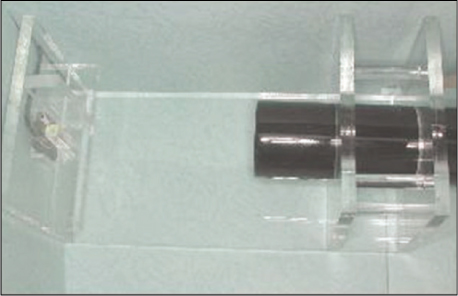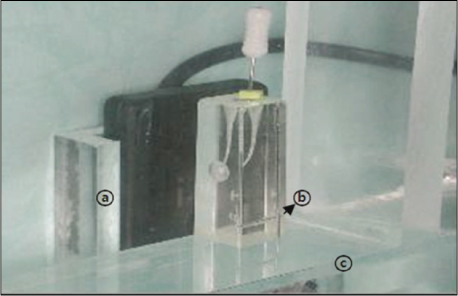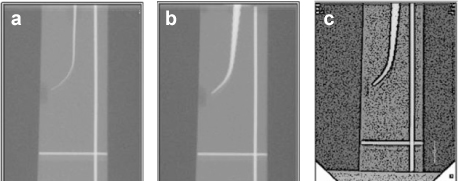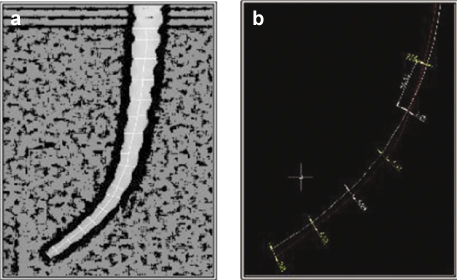J Korean Acad Conserv Dent.
2011 Jan;36(1):59-65. 10.5395/JKACD.2011.36.1.59.
Comparison of apical transportation and change of working length in K3, NRT AND PROFILE rotary instruments using transparent resin block
- Affiliations
-
- 1Department of Conservative Dentistry, Yonsei University College of Dentistry, Seoul, Korea. andyendo@yuhs.ac
- 2Department of Conservative Dentistry, Gangnam Severance Hospital, Yonsei University College of Dentistry, Seoul, Korea.
- KMID: 1446084
- DOI: http://doi.org/10.5395/JKACD.2011.36.1.59
Abstract
OBJECTIVES
The purpose of this study is to compare the apical transportation and working length change in curved root canals created in resin blocks, using 3 geometrically different types of Ni-Ti files, K3, NRT, and Profile.
MATERIALS AND METHODS
The curvature of 30 resin blocks was measured by Schneider technique and each groups of Ni-Ti files were allocated with 10 resin blocks at random. The canals were shaped with Ni-Ti files by Crown-down technique. It was analyzed by Double radiograph superimposition method (Backman CA 1992), and for the accuracy and consistency, specially designed jig, digital X-ray, and CAD/CAM software for measurement of apical transportation were used. The amount of apical transportation was measured at 0, 1, 3, 5 mm from 'apical foramen - 0.5 mm' area, and the alteration of the working length before and after canal shaping was also measured. For statistics, Kruskal-Wallis One Way Analysis was used.
RESULTS
There was no significant difference between the groups in the amount of working length change and apical transportation at 0, 1, and 3 mm area (p = 0.027), however, the amount of apical transportation at 5 mm area showed significant difference between K3 and Profile system (p = 0.924).
CONCLUSIONS
As a result of this study, the 3 geometrically different Ni-Ti files showed no significant difference in apical transportation and working length change and maintained the original root canal shape.
Keyword
Figure
Cited by 1 articles
-
A comparison of dimensional standard of several nickel-titanium rotary files
Ki-Won Kim, Kyung-Mo Cho, Se-Hee Park, Ki-Yeol Choi, Bekir Karabucak, Jin-Woo Kim
Restor Dent Endod. 2014;39(1):7-11. doi: 10.5395/rde.2014.39.1.7.
Reference
-
1. Schilder H. Cleaning and shaping the root canal. Dent Clin North Am. 1974. 18(2):269–296.2. al-Omari MA, Dummer PM, Newcombe RG, Doller R. Comparison of six files to prepare simulated root canals. 2. Int Endod J. 1992. 25(2):67–81.
Article3. Schafer E, Tepel J, Hoppe W. Properties of endodontic hand instruments used in rotary motion. Part 2. Instrumentation of curved canals. J Endod. 1995. 21(10):493–497.
Article4. Roane JB, Sabala CL, Duncanson MG Jr. The "balanced force" concept for instrumentation of curved canals. J Endod. 1985. 11(5):203–211.
Article5. Abou-Rass M, Frank AL, Glick DH. The anticurvature filing method to prepare the curved root canal. J Am Dent Assoc. 1980. 101(5):792–794.
Article6. Caldwell JL. Change in working length following instrumentation of molar canals. Oral Surg Oral Med Oral Pathol. 1976. 41(1):114–118.
Article7. Civjan S, Huget EF, DeSimon LB. Potential applications of certain nickel-titanium (nitinol) alloys. J Dent Res. 1975. 54(1):89–96.
Article8. Walia HM, Brantley WA, Gerstein H. An initial investigation of the bending and torsional properties of Nitinol root canal files. J Endod. 1988. 14(7):346–351.
Article9. Gambill JM, Alder M, del Rio CE. Comparison of nickel-titanium and stainless steel hand-file instrumentation using computed tomography. J Endod. 1996. 22(7):369–375.
Article10. Glossen CR, Haller RH, Dove SB, del Rio CE. A comparison of root canal preparations using Ni-Ti hand, Ni-Ti engine-driven, and K-Flex endodontic instruments. J Endod. 1995. 21(3):146–151.
Article11. Elliott LM, Curtis RV, Pitt Ford TR. Cutting pattern of nickel-titanium files using two preparation techniques. Endod Dent Traumatol. 1998. 14(1):10–15.
Article12. Bergmans L, Van Cleynenbreugel J, Wevers M, Lambrechts P. Mechanical root canal preparation with NiTi rotary instruments: rationale, performance and safety. Status report for the American Journal of Dentistry. Am J Dent. 2001. 14(5):324–333.13. Bryant ST, Thompson SA, al-Omari MA, Dummer PM. Shaping ability of Profile rotary nickel-titanium instruments with ISO sized tips in simulated root canals: Part 1. Int Endod J. 1998. 31(4):275–281.
Article14. Bramante CM, Berbert A, Borges RP. A methodology for evaluation of root canal instrumentation. J Endod. 1987. 13(5):243–245.
Article15. Garip Y, Gunday M. The use of computed tomography when comparing nickel-titanium and stainless steel files during preparation of simulated curved canals. Int Endod J. 2001. 34(6):452–457.
Article16. Backman CA, Oswald RJ, Pitts DL. A radiographic comparison of two root canal instrumentation techniques. J Endod. 1992. 18(1):19–24.
Article17. Glickman GN, Koch KA. 21st-century endodontics. J Am Dent Assoc. 2000. 131:Suppl. 39S–46S.
Article18. Pruett JP, Clement DJ, Carnes DL Jr. Cyclic fatigue testing of nickel-titanium endodontic instruments. J Endod. 1997. 23(2):77–85.
Article19. Bonetti Filho I, Miranda Esberard R, de Toledo Leonardo R, del Rio CE. Microscopic evaluation of three endodontic files pre- and postinstrumentation. J Endod. 1998. 24(7):461–464.
Article20. Weine FS, Kelly RF, Lio PJ. The effect of preparation procedures on original canal shape and on apical foramen shape. J Endod. 1975. 1(8):255–262.
Article21. Lim KC, Webber J. The validity of simulated root canals for the investigation of the prepared root canal shape. Int Endod J. 1985. 18(4):240–246.
Article22. Dummer PM, Alodeh MH, al-Omari MA. A method for the construction of simulated root canals in clear resin blocks. Int Endod J. 1991. 24(2):63–66.
Article23. Cha YB, Jung IY, Lee SJ, et al. Shaping ability of three ProFile rotary instrumentation techniques in simulated resin root canals. J Endod. 2000. 26(12):719–723.
Article24. Thompson SA, Dummer PM. Shaping ability of ProFile.04 Taper Series 29 rotary nickel-titanium instruments in simulated root canals. Part 1. Int Endod J. 1997. 30(1):1–7.25. Schafer E, Florek H. Efficiency of rotary nickel-titanium K3 instruments compared with stainless steel hand K-Flexofile. Part 1. Shaping ability in simulated curved canals. Int Endod J. 2003. 36(3):199–207.
Article26. Iqbal MK, Maggiore F, Suh B, Edwards KR, Kang J, Kim S. Comparison of apical transportation in four Ni-Ti rotary instrumentation techniques. J Endod. 2003. 29(9):587–591.
Article
- Full Text Links
- Actions
-
Cited
- CITED
-
- Close
- Share
- Similar articles
-
- The effect of gutta-percha removal using nickel-titanium rotary instruments
- Comparison of screw-in effect for several nickel-titanium rotary instruments in simulated resin root canal
- A study on transportation of apical foramen after overinstrumentation by ProFile(R), ProTaper(TM) and K3TM in simulated canals with different curvatures
- The instrument-centering ability of four Nickel-Titanium instruments in simulated curved root canals
- Influence of taper on the screw-in effect of nickel-titanium rotary files in simulated resin root canal





